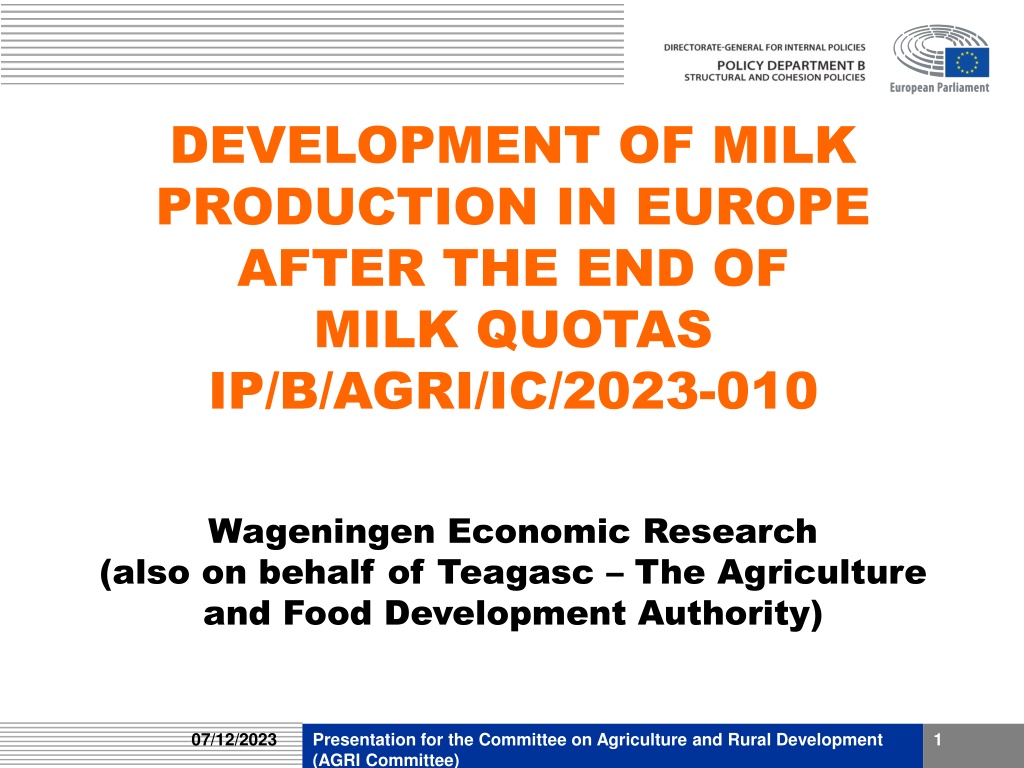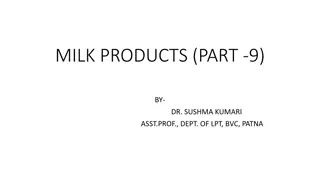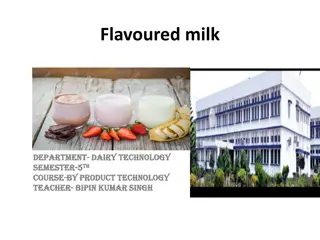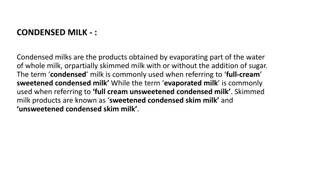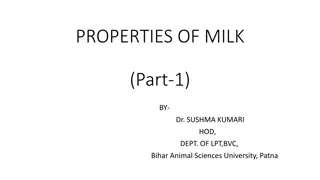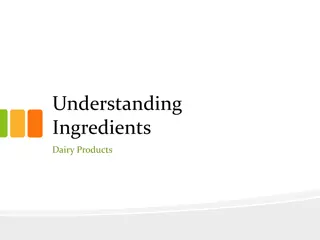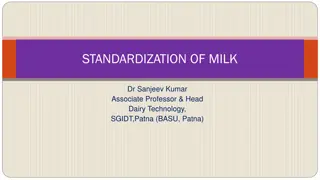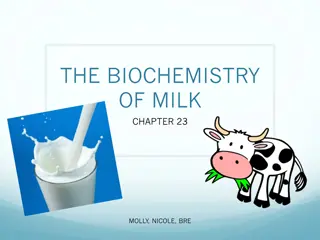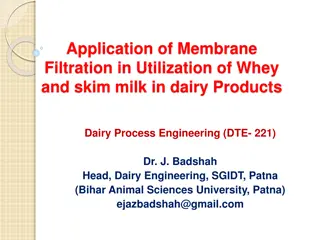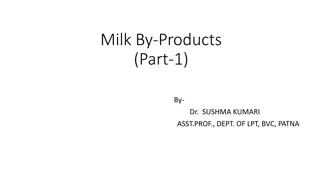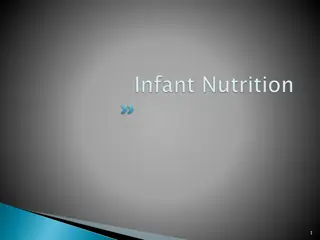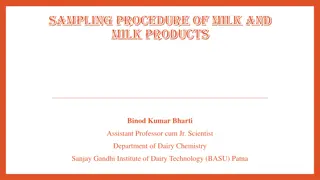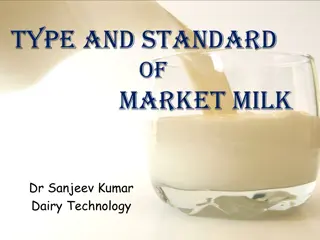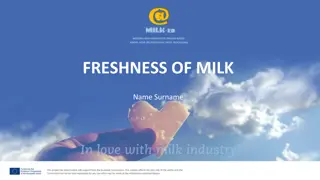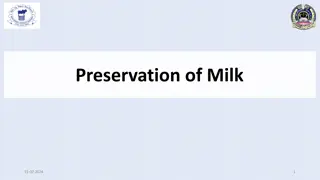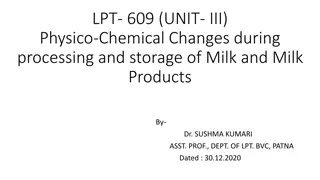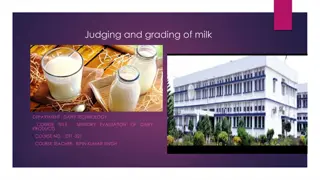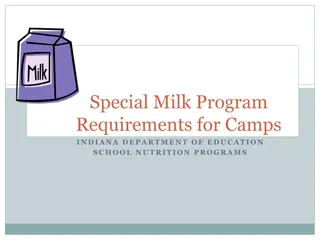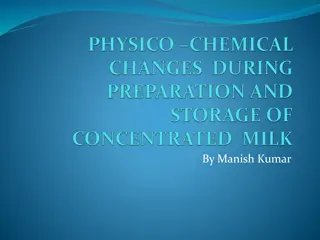Development of Milk Production in Europe Post-Quota Abolition
The presentation evaluates challenges and opportunities for the EU dairy sector following the abolition of milk quotas in Europe. It reviews policy developments, context, structure, and functioning of the dairy sector. With insights from official data sources and consultation with key industry players, the presentation highlights dynamics in the post-quota period, prospects, challenges, policy interventions, and concludes with recommendations for sustainable growth.
Download Presentation

Please find below an Image/Link to download the presentation.
The content on the website is provided AS IS for your information and personal use only. It may not be sold, licensed, or shared on other websites without obtaining consent from the author. Download presentation by click this link. If you encounter any issues during the download, it is possible that the publisher has removed the file from their server.
E N D
Presentation Transcript
DEVELOPMENT OF MILK PRODUCTION IN EUROPE AFTER THE END OF MILK QUOTAS IP/B/AGRI/IC/2023-010 Wageningen Economic Research (also on behalf of Teagasc The Agriculture and Food Development Authority) 07/12/2023 Presentation for the Committee on Agriculture and Rural Development (AGRI Committee) 1
Structure of the Presentation Structure of the Presentation 1. 2. 3. 4. 5. 6. 7. Aim and approach Context Structure and functioning of the dairy sector Dynamics in the post-quota period Prospects and challenges Policy interventions Conclusions and recommendations 07/12/2023 Presentation for the Committee on Agriculture and Rural Development (AGRI Committee) 2
1. Aim and approach 1. Aim and approach Aim Evaluate challenges/opportunities for EU dairy sector after milk quota abolition Approach Literature review of scientific articles, policy reports, policy briefings, etc. Descriptive analysis based on official data sources, including FADN, Eurostat, Comext, FAO, etc. Consultation with key actors from the EU dairy market, including EDA, Eucolait, dairy industry and farm organisations 07/12/2023 Presentation for the Committee on Agriculture and Rural Development (AGRI Committee) 3
2. Context 2. Context Policy developments Abolition of milk quotas in April 2015 Various CAP reforms/Evolving EU sustainability agenda EU expansion General trends Declining cow numbers, rising milk yields, fewer dairy farms and larger average dairy farm size, rising farmer age profile Overall impacts Strong increase in EU dairy production in last 20 years Exploitation of economies of scale associated with quota abolition Policy interventions contributed to growth of EU dairy product exports to the world market 07/12/2023 Presentation for the Committee on Agriculture and Rural Development (AGRI Committee) 4
3. Structure and functioning of the 3. Structure and functioning of the sector (1) sector (1) Global EU/NZ are main dairy exporters, both with a global market share of about 24%, US next with 13% Prices Milk quota abolition and CAP reform have allowed world dairy market prices to converge towards the EU level EU prices reflect the volatility in world prices Supply chains High degree of heterogeneity even within a single product category Cooperatives have a high market share in the Scandinavian MS, Ireland, the Netherlands, France and Austria (all with a market share of more than 50%) 07/12/2023 Presentation for the Committee on Agriculture and Rural Development (AGRI Committee) 5
3. Structure and functioning of the 3. Structure and functioning of the sector (2) sector (2) Figure 1. Comparison between New Zealand and EU milk prices (USD per tonne) Source: FAOStat data 07/12/2023 Presentation for the Committee on Agriculture and Rural Development (AGRI Committee) 6
4. Dynamics in the post 4. Dynamics in the post- -quota period Prices Sector less insulated from global developments More volatile EU farm milk prices in last 15 years, especially in MSs with a greater export orientation Input prices Volatile feed, fertiliser and energy prices Farm income Volatile production costs and milk prices = volatile EU dairy farm incomes Environmental policy Exerting an increasing influence over the EU dairy sector, whether enacted at EU or MS level Disadvantaged regions Dairy farms in such regions face additional challenges relative to dairy farms generally quota period 07/12/2023 Presentation for the Committee on Agriculture and Rural Development (AGRI Committee) 7
5. Prospects and challenges (1) 5. Prospects and challenges (1) Competitiveness Belgium, Denmark, Luxembourg, Ireland, the Netherlands and the UK are the most competitive countries Farm structures impact on competitive performance Opportunity cost of owned resources Important consideration in longer-term competitiveness of the sector Incomes Specialised milk farms had higher incomes per annual work unit (AWU) than the average EU farm, but were not among the top 3 best performing farm types in recent years Economic opportunities New value added products, new markets, technology adoption, supply chain optimisation 07/12/2023 Presentation for the Committee on Agriculture and Rural Development (AGRI Committee) 8
5. Prospects and challenges (2) 5. Prospects and challenges (2) Economic challenges Dairy farmers in a vulnerable "price taker" position in dairy supply chain Challenges compounded by lag in price transmission along the chain Environmental opportunities Renewables, circularity, certification and labelling, sustainable feeds and pasture Environmental challenges Nutrient surpluses, GHG emissions, water, biodiversity Social opportunities Local markets, social sustainability initiatives, consumer education, gender equality Social challenges Animal welfare, work-life balance, availability of labour, generational renewal 07/12/2023 Presentation for the Committee on Agriculture and Rural Development (AGRI Committee) 9
6. Policy interventions 6. Policy interventions Key developments EU dairy policy stems from 1960s Milk quota operated 1984 to 2015 Soft landing -> from April 2009, quotas increased by 1% a year over five years EU milk sector is covered by CMO Regulation (EU) No 1308/2013 of the European Parliament Important role of farm income support in dairy sector Direct payments (SE606) represent about 40% of dairy farm net income on average 07/12/2023 Presentation for the Committee on Agriculture and Rural Development (AGRI Committee) 10
7. Conclusions and recommendations (1) 7. Conclusions and recommendations (1) Economic: Price volatility Conclusion Dairy commodity price volatility is a feature of the global dairy market Dairy production costs also volatile due to feed, fertiliser and energy price volatility By contrast, EU dairy farmer CAP support is relatively stable in value terms Recommendation Could promote fixed milk price contracts, allowing dairy farmers lock in a milk price However, these contracts do not guarantee the dairy farmer s profit margin, input cost volatility and production (weather) risks remain 07/12/2023 Presentation for the Committee on Agriculture and Rural Development (AGRI Committee) 11
7. Conclusions and recommendations (2) 7. Conclusions and recommendations (2) Environment: Nutrient surpluses Conclusion Manure-related nutrient surpluses, especially in environmental hotspots, create pressure on the environment, with a negative impact on biodiversity quality in Natura 2000 areas Regionally tailored policy approaches to such areas would be most appropriate Recommendation To provide farmers with nutrient management tools (e.g. ANCA) to track KPIs To attach levies and/or payments to nutrient management KPI performance 07/12/2023 Presentation for the Committee on Agriculture and Rural Development (AGRI Committee) 12
7. Conclusions and recommendations (3) 7. Conclusions and recommendations (3) Environment: Climate/Greenhouse Gases Conclusion No individual incentive for dairy farmers to reduce their GHG emissions Measuring the production of GHGs on individual dairy farms is more complex than measuring emissions on the processor s side Recommendation Emission rights, carbon prices, incentivise the dairy farmer to adopt emission reduction technologies Specific support could be provided to address the cost of adoption of technologies to reduce emissions 07/12/2023 Presentation for the Committee on Agriculture and Rural Development (AGRI Committee) 13
7. Conclusions and recommendations (4) 7. Conclusions and recommendations (4) Others Conclusion Increasing the area in organic farming is a priority (there are concerns about organic premiums) Dairy farming in disadvantaged regions face stronger uncertainty (limited or no farming alternatives) Availability of labour and generational renewal are key challenges Recommendation Certification of suitable/selected production systems Support technology adoption that reduce labour input Tailor regional approaches to support farming in disadvantaged regions 07/12/2023 Presentation for the Committee on Agriculture and Rural Development (AGRI Committee) 14
